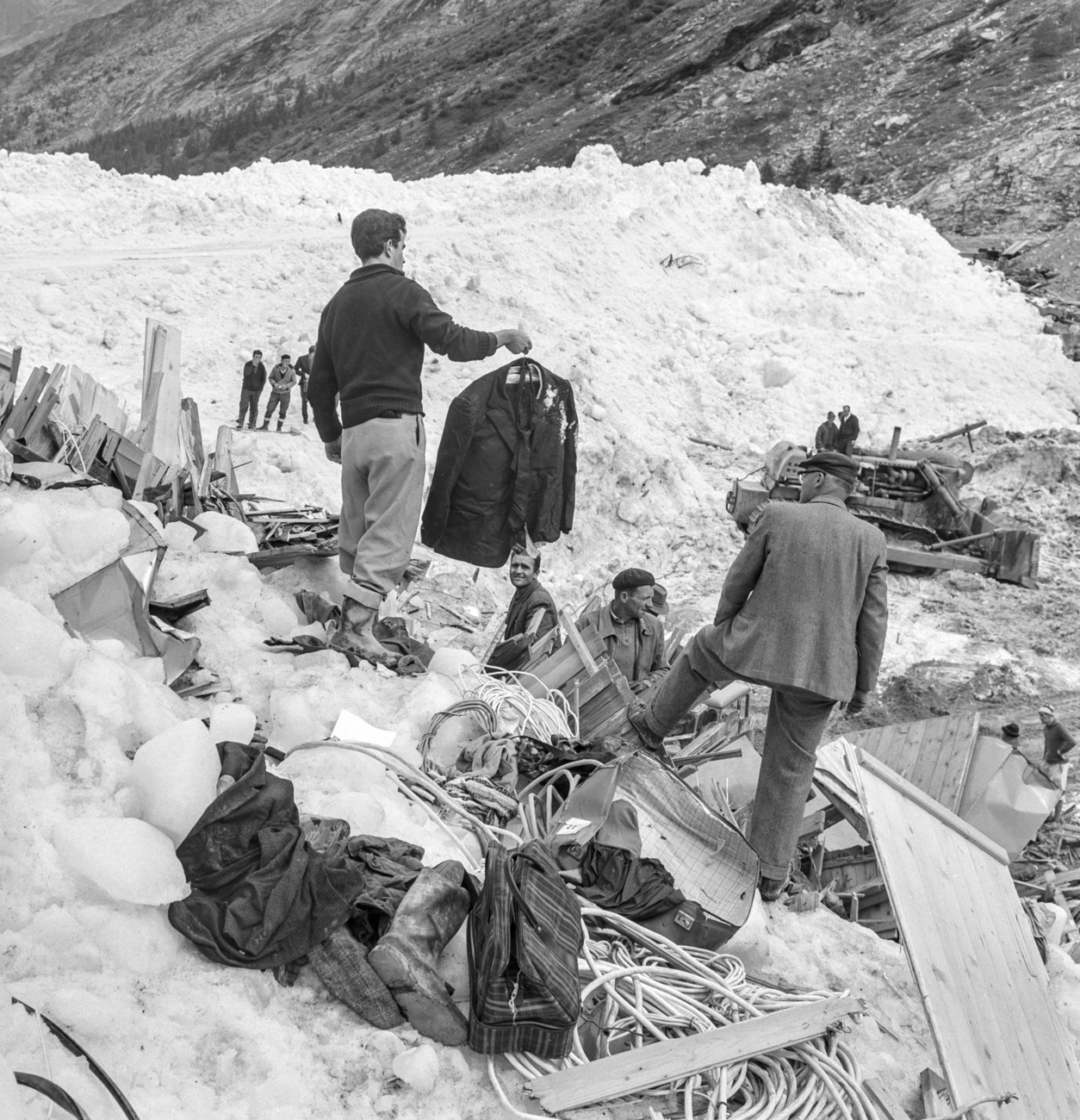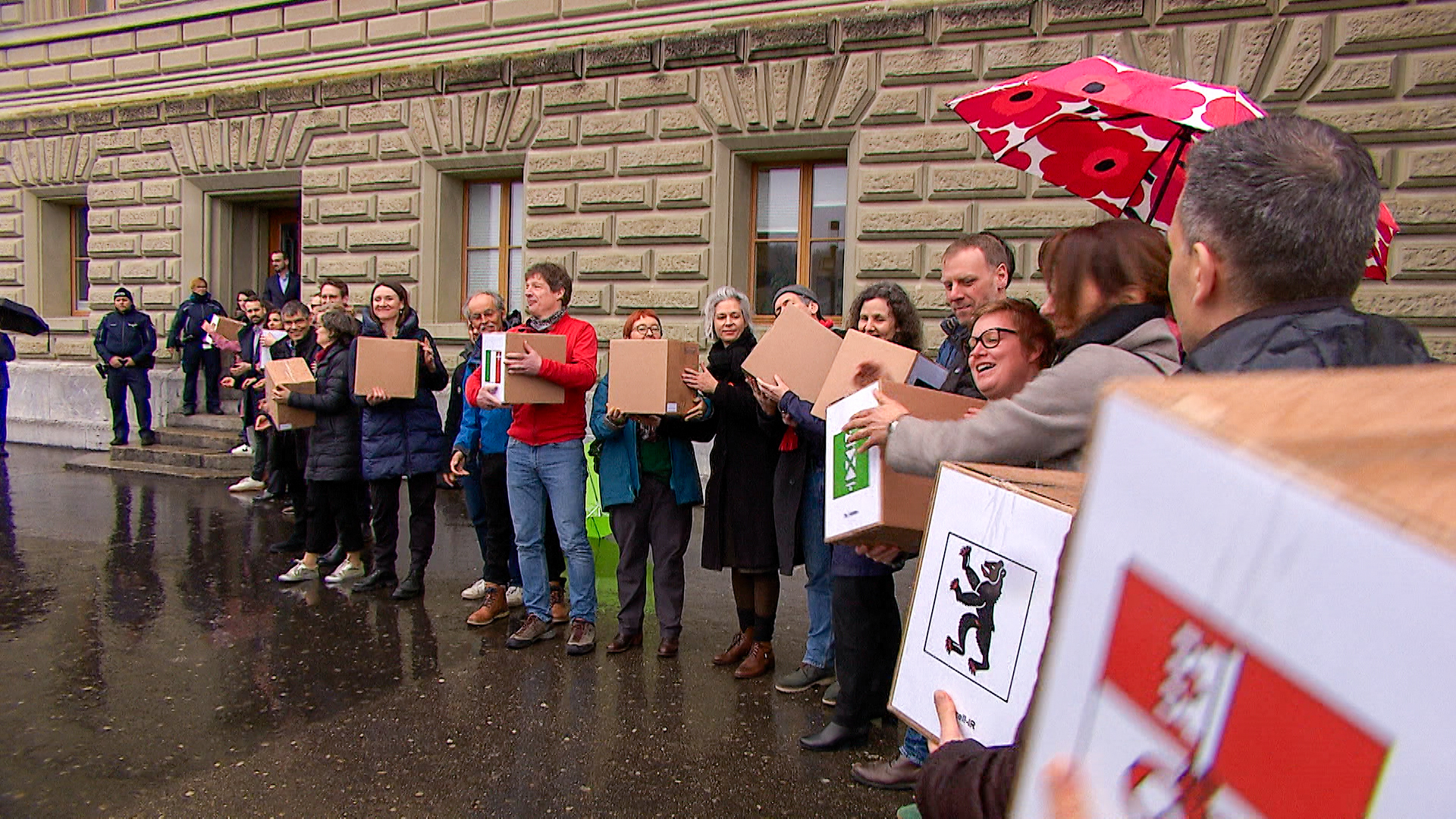
Was the worst Swiss disaster an ‘unforeseeable event’?

The worst disaster in Swiss history, in which 88 people perished after two million cubic metres of ice and debris plunged onto a dam construction site, was dismissed as an “unforeseeable event”. Sixty years after the Mattmark tragedy, the survivors’ memories persist. So do the shadows of a trial in which all of the accused were acquitted, amid political and economic pressure.
It’s impossible to say if it was providence, fate or luck that saved Ilario Bagnariol on August 30, 1965.
“I don’t know how I managed to survive,” says the 83-year-old. “No one can tell me, not even Father Costante, who is with us each year at the ceremony in memory of the victims.”
The former bulldozer driver at the Mattmark dam construction site remembers that Monday 60 years ago as if it were yesterday. “It was a day like any other, and I was preparing material for the construction of the dam,” he says in Ins, a village in canton Bern, where he has lived since 1971. “I’d just shifted a huge boulder when I turned around and saw the icy tongue of the glacier breaking off above me. Blocks the size of houses came crashing down the mountainside. Seconds later, the barracks village had disappeared.”

Bodies torn apart by the ice
It was 5:15pm. Two million cubic metres of ice and debris engulfed the Mattmark construction site, burying 88 workers: 56 Italians, 23 Swiss, four Spaniards, two Austrians, two Germans and one stateless person.
“We were all friends. We were like family,” Bagnariol recalls, showing photographs from the time. Originally from Fiume Veneto, in the northern Italian province of Pordenone, he emigrated young, at age 19, to Luxembourg, where he learned to operate a bulldozer. When the construction site there was about to close, a fellow worker from Bern suggested he join him in Switzerland for work on the Mattmark dam.

“After returning home, I travelled to Brig, passed the medical check, and then continued on my way to Saas-Almagell,” sasy Bagnariol. “The last kilometre I did on foot.” The next day he was already on the construction site, over 2,000 metres above sea level, surrounded by the majestic mountains of the Upper Valais. Here, too, he was put in charge of a bulldozer.
That was in 1963. Two years later, he witnessed the worst disaster in modern Swiss history. “It was absolutely terrifying,” Bagnariol says. “With my boss, I ran to get a loader and started searching right away, turning up the ice from the bottom. I worked late into the night.” The next day, he returned to the scene of the tragedy. The sight was horrific: the ice had literally dismembered the victims’ bodies. In nearby Zermeiggern, the bodies were laid out in coffins lining the largest room of the infirmary. Only once they had been completely reassembled were they returned to their families.
“One day I discovered a torso, with no arms or legs. I knew it was Giuseppe because he had a packet of HB cigarettes in his pocket,” says the octogenarian. “There were only two men who smoked them, out of over a thousand workers. The other, an Austrian, had survived.”
Bagnariol’s friend Mario Fabbiane, a mechanic from Sedico, in Belluno province in northern Italy, was also buried under several metres of ice. He was one of the 17 victims from Belluno.
“He was my roommate and was looking forward to receiving the phone call from his wife announcing the birth of their first child,” Bagnariol sayss. “Instead, fate decided that the call would be made from the construction site to announce his death.”
Masters of nature
A novel based on the Mattmark tragedy has just been published: Ein unvorhersehbares Ereignis (An Unforeseeable Event), by Urs HardeggerExternal link.
“My goal was not just to tell the bare facts, but to place them in a broader context, describing the atmosphere of those years through the eyes of the people who worked on building the dam, who came from different cultural and social backgrounds,” the author explains. “On the one hand there were the migrants, forced to leave their countries in the hope of improving their economic situation; and on the other there was Switzerland, which needed workers but often showed a hostile attitude towards them.”
In the 1950s, at the start of the planning phase, the first experts and workers arrived in the Saas Valley in Upper Valais to carry out surveys and drilling.
“It was the middle of an economic boom, and there was huge faith in progress and technological development,” Hardegger says. “It seemed as if everything was possible – even mastering nature.”
As this first stage came to an end, the foreign workforce – in large part Italian – grew rapidly. In 1963 there were 1,400 workers, mainly housed in the barracks village at Zermeiggern, just over a kilometre above Saas-Almagell. Other dormitories and offices were initially located south of the dam, in the reservoir basin, but in the mid-1960s they were moved to the northern side, just below the Allalin Glacier. To reduce the movement of workers and speed up construction, the management decided to build more and more barracks – accommodation, offices, workshops and canteens – directly in the path of the glacier.
In the book Mattmark 1965 – Erinnerungen, Gerichtsurteile, italienisch-schweizerische Verflechtungen (Mattmark 1965 – Memories, Court Rulings, Italian-Swiss Interlinkages) by Elisabeth Joris, Thomas Burgener recalls in an essay his meeting with Italian theatre director Germano Rossi. The latter had contacted him in 2023 as he wanted to stage the Mattmark tragedy, together with his children and a group of young people.
The play, The Shape of the Wind, premiered on June 1, 2024, in Treviso, in northern Italy. It re-enacts the trial and the pressures endured by judge Paul-Eugen Burgener, Thomas’s father. Characters inspired by Swiss federal politician Roger Bonvin and ETH Zurich professor Gerold Schnitter appear on stage. As well as commemorating the tragedy, the performance sought to make people reflect on the climate of xenophobia prevailing at the time, while relating it to current developments in Switzerland and Italy.
A truly unpredictable disaster?
In 1965, the author Hardegger was eight years old. He can still remember his parents’ reaction when they learned of the disaster, and the name Mattmark has remained etched in his memory. Three years ago, he decided to dedicate a book to the tragedy, and set about finding out as much as he could about it. With the end of the secrecy period, in 2022 he was able to read the court documents.
Despite the title of his work – An Unforeseeable Event – the disaster was anything but unexpected, the writer says: “The catastrophe was, in fact, foretold well in advance. Witnesses reported that larger and larger blocks of ice were falling from the glacier. Yet the glacier was never monitored, and no warning system was installed, despite recommendations by experts.”

The novel thus also puts a spotlight on the question of responsibility for the deaths of 88 people. Was the collapse of the glacier truly unpredictable, as two prominent Swiss figures – federal politician Roger Bonvin from canton Valais and professor Gerold Schnitter of the federal technology institute ETH Zurich – immediately claimed? Their assessment was taken up like a mantra by the Swiss media.
“Yet they were not neutral observers,” Kurt Marti wrote in an essay published in the work Mattmark 1965External link by historian Elisabeth Joris. “In the early planning stages of Mattmark, Roger Bonvin had worked as an engineer for the construction company Elektrowatt AGExternal link […]. Meanwhile, Gerold Schnitter […] had a conflict of interest.”

‘A great injustice’
After a seven-year investigation, a trial was held in 1972 at the Visp district court. It resulted in the acquittal of all 17 defendants. Later that year, in September, the sentence was upheld on appeal by the cantonal court in Sion. This verdict sparked outrage in Italy, especially since the appellants, almost all families of the victims, were charged half of the court costs, which were then covered by the Italian government.

One of the five judges at the Sion cantonal court was Paul-Eugen Burgener. He was appointed by the court to study the files, prepare a report and propose a judgment. Today, his son Thomas BurgenerExternal link – a former Social Democratic member of the federal parliament and the Valais cantonal government – recalls the dedication with which his father took on the task. “I was 18 at the time, and we spent that summer in a chalet up at 1,300 metres in canton Valais,” he recalls. “My father would get up at five o’clock every morning and spend four hours studying the documents that were contained in seven apple crates. In his 80-page proposal, he recommended the conviction of four Elektrowatt AG executives for involuntary manslaughter.”
In addition to various scientific reports, Paul-Eugen Burgener based his proposal on an international expert report drafted in 1967 by three specialists from Austria, Germany and France, commissioned by the investigating judge. His request for a conviction was, however, rejected: the other judges outvoted him.
The court was under heavy political pressure – the defendants were part of the top management of major Swiss electricity companies. There was also economic pressure, as the construction site had brought jobs and prosperity to the region.
“My father never accepted that sentence, and after the trial he was never the same,” his son says. “Some weeks before he died, at age 84, he spoke to me about it again, saying that a great injustice had been done.”
Edited by Daniele Mariani. Adapted from Italian by Julia Bassam/gw

In compliance with the JTI standards
More: SWI swissinfo.ch certified by the Journalism Trust Initiative




























You can find an overview of ongoing debates with our journalists here . Please join us!
If you want to start a conversation about a topic raised in this article or want to report factual errors, email us at english@swissinfo.ch.